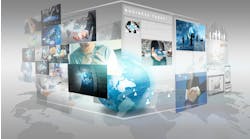I, at times, envy someone just entering our field. Whether they know it or not, it may be beneficial to have all of this technology we currently experience presented to them from day one. Those of us, on the other hand, that have been at it for some time find ourselves learning or relearning what we don't or thought we knew. Today's electronic safety-related systems make it a better world for all. Like most everything else automotive it has been a bit of an evolution to get to this point. I don't regret not having them in the mid 80's learning to drive in muscle cars that were 20 plus years old back then.
I'm proud to say power brakes were an exciting upgrade to have! I'm pretty sure our style of driving on the back roads of rural Kentucky would have confused sensors to the point of quitting and walking away from the cars if they were able. You can think of real-life “Dukes of Hazzard” if you need a visual reference. I suppose it was divine intervention that allowed me to be here today. Young and old today benefit from the systems in place currently and there is no doubt countless lives have been saved. That notion goes to the importance of these systems and one, in particular, we will dig deeper into. Before we do, I need to set the stage as to why we must know more than just the basics of a component or system.
I'm the first to admit there is no one that I have met that is an expert on all subjects related to automotive collision repair. It's critically important in today's evolution of vehicles to swallow the “pill of humility” and broaden our thought process. Myself included. It's one of the best ways to stay current. Once you realize that you don't know everything, learning becomes a lot easier. It's even more enjoyable when you conclude that it's an ongoing process for us in this field. It's not to say all of our years of experience are irrelevant, they most certainly are not. It's just that we need to keep learning new things about what we may already “know.”
There are times when we know a little about a subject and that amount of knowledge will suffice. Steering angle sensors maybe just one of those topics for most. I'm going to go further in-depth on what they are and what function they perform. It's always useful to have as much understanding of various systems as practicable. I hope you will use this subject in particular to reinforce the need for an open mind and continuing education. I'm going to climb down from my “continuing education” soapbox and prove why it's important to learn more about a topic than just the basics.
It may be that you’re familiar with steering angle sensors, or SAS as they are commonly referred to, in that you know it must be calibrated in certain scenarios. The SAS is just one of many components that exist in an ESC (electronic stability control) system. Keep in mind ESC was mandated some years back so it's a system that is no longer optional but required. That means that before too long virtually every vehicle in your shop will be equipped with it. Now that we know it is here to stay let's look at what the SAS does and how it relates to other systems as well.
The function of the sensor is to measure the steering wheel position angle and the rate of turn. More simply put it may determine where the front wheels are pointed. They are typically located in the steering column and work in conjunction with the ADAS systems on today's vehicles. It may affect lane keep assist, blind-spot detection, and possibly more. It may be that the system as more than one sensor in the cluster located in the column. The reason for more than one sensor may be related to redundancy within the system and/or to confirm data.
The ESC module may require two separate signals to confirm the data. Different types of sensors may send data through low voltage outputs as the steering wheel is turned or they may be a digital type using LED light with a shutter/optic sensor measuring the amount of light emitted in relation to the position of the steering wheel. Locations and types vary by manufacturer. One example of location may be that near the clockspring or sometimes called the spiral cable assembly. This different nomenclature and location support the need to keep an open mind when it comes to the particular manufacturer and model of vehicle your working on. What it was called and where it was located last week could be wholly different this week depending on the vehicle.
The most common way a shop will encounter steering angle sensors is related to an operation that requires the SAS to be calibrated. It may be necessary due to changing or removing certain parts that can affect its operation. Typically they will need to be calibrated due to a wheel alignment as well. More on “when” it's necessary will be covered later.
So now that we understand calibrations to this system are common as the frequency of these systems has increased in the vehicles we have in the shop and will continue to grow as time passes, it's as important to know “why” we are calibrating more often. If any of the systems within the ADAS family are not calibrated or if they are incorrectly calibrated they may not perform correctly. It's critically important to be mindful of what operations are being performed during the repair process so that all necessary calibrations will be performed at the end of the process. Technicians and estimators/repair planners must strive to include all related operations in the initial phase. You must ask yourself “if I do this, does that mean I will need to do that as well?”. This, once again, goes to the open mind thought process.
The next logical question is when should a SAS need to be calibrated or relearned as its sometimes referred to? We would assume the most common occurrence would be during a wheel alignment, but there may be other instances as well. Some of the conditions may be when a battery has been disconnected, the SAS connector has been unplugged such as when a steering column has been removed to be measured for the proper length following a collision or other reasons called out by the vehicle manufacture.
There is also the possibility the system may not be able to be calibrated or relearned if an associated system is not functioning properly. It is here where we need to broaden our scope when thinking about calibrations of all types. It is important to remember that most often several systems work in conjunction with each other and there may be several reasons that contribute to calibration needs. SAS may work with the yaw, wheel speed, and accelerometer sensors just to name a few. All of the information gathered from these systems may combine to alert the SCS of the intentions of the driver or monitor what is going on currently with the vehicle as it is being driven. It may be that this information is assessed to give the ABS a “guideline” to act if needed. I hope this paints a picture of how important these systems are when it's related to safety.
Now that we understand steering angle sensors are a big part of an even bigger system we can go over the possible ways calibrations may take place. Just as there are several different reasons a SAS may need to be calibrated there may also be several ways in which that calibration will be performed. Scan tools are commonly used for many functions in today's collision repair facilities and may very well be a part of the calibration process. The vehicle manufacturer may have a static, dynamic, or combination of both processes. As always it is paramount to follow the OEM guidelines when performing these procedures. The process of calibrating the sensor may also calibrate other sensors at the same time. This goes to the earlier point of different systems working in concert with each other. Calibration with a scan tool may require the vehicle to driven a short distance during the process or there may be other steps that take place in conjunction with the communication phase. It may be there is a calibration process that does not require the use of a scan tool.
In conclusion, we can see that there is a lot more than meets the eye when it comes to steering angle sensors. The most important aspect to remember is that it's one part of a larger system and there may be several reasons that require a calibration beyond the typical wheel alignment. As always follow the OEM guidelines for that particular vehicle including Make, model, and year. For additional information I-Car offers a one-hour online course titled Steering Angle Sensor Overview and Diagnostics the description is as follows:
Steering Angle Sensor Overview and Diagnostics course begins with an explanation of what steering angle and steering angle sensors are and how they affect the drivability of the vehicle. Next the course will cover the related parts and systems related to steering angle. Common problems that can face steering angle sensors will also be discussed along with proper damage analysis. The course wraps up with requirements for steering angle sensor reset and calibration.
After completing this course, you will be able to:
• Explain steering angle
• Describe the function of the steering angle sensor
• List the parts and systems related to the steering angle sensor
• Describe the problems that can affect the steering angle sensor
• Explain how to diagnose a steering angle sensor
• How to reset and calibrate a steering angle sensor
With all that has been presented I hope is that you will see more of a “big picture” scenario as the systems in today's vehicles are, more than ever, interrelated. That is a trend that is here to stay and will only be more pronounced in the future. Make all necessary calibrations and leave the envelope-pushing to Bo and Luke!





